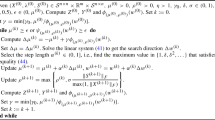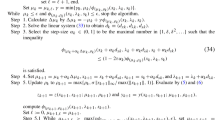Abstract
We propose IPRQP, an enhanced primal-dual interior-point relaxation method (IPRM), for solving convex quadratic programming. This method is based on a smoothing barrier augmented Lagrangian function for convex quadratic programming. IPRQP inherits the advantages of IPRM, including not requiring iterative points to be interior points, which makes IPRQP suitable for the warm-starting of combinatorial optimization problems. Compared to IPRM, the customized starting points allow the line search of IPRQP to contain only vector operations. In addition, IPRQP improves the updating scheme of the barrier parameter and provides a certificate of infeasibility. Some results on global convergence are presented. We implement the algorithm on convex quadratic programming problems from Maros-Mészaros and the benchmark problem sets NETLIB and Kennington, which contain feasible and infeasible linear programming problems. The numerical results show that our algorithm is reliable for feasible problems and efficient for detecting the infeasibility of infeasible problems.





Similar content being viewed by others
Data availability
The data that support the findings of this study are available from the corresponding author upon reasonable request.
References
Banjac, G., Goulart, P., Stellato, B., Boyd, S.: Infeasibility detection in the alternating direction method of multipliers for convex optimization. J. Optim. Theory Appl. 183(2), 490–519 (2019)
Cartis, C., Gould, N.I.: Finding a point in the relative interior of a polyhedron (2007)
Cheshmi, K., Kaufman, D.M., Kamil, S., Dehnavi, M.M.: NASOQ: numerically accurate sparsity-oriented QP solver. ACM Trans. Graph. (TOG) 39(4), 96–1 (2020)
Dai, Y.H., Liu, X.W., Sun, J.: A primal-dual interior-point method capable of rapidly detecting infeasibility for nonlinear programs. J. Ind. Manag. Optim. 16(2), 1009–1035 (2020)
Di Gaspero, L.: Quadprog++: a C++ library for quadratic programming which implements the Goldfarb-Idnani active-set dual method (2016)
Dolan, E.D., More, J.J.: Benchmarking optimization software with performance profiles. Math. Program. 91(2), 201–213 (2002)
Ferreau, H.J., Kirches, C., Potschka, A., Bock, H.G., Diehl, M.: qpOASES: a parametric active-set algorithm for quadratic programming. Math. Program. Comput. 6(4), 327–363 (2014)
Frison, G., Diehl, M.: HPIPM: a high-performance quadratic programming framework for model predictive control. IFAC-PapersOnLine 53(2), 6563–6569 (2020)
Gertz, E.M., Wright, S.J.: Object-oriented software for quadratic programming. ACM Trans. Math. Softw. (TOMS) 29(1), 58–81 (2003)
Gilbert, J.C., Joannopoulos, É.: OQLA/QPALM–convex quadratic optimization solvers using the augmented Lagrangian approach, with an appropriate behavior on infeasible or unbounded problems (2014)
Gondzio, J.: Warm start of the primal–dual method applied in the cutting-plane scheme. Math. Program. 83(1), 125–143 (1998)
Gondzio, J.: Matrix-free interior point method. Comput. Optim. Appl. 51(2), 457–480 (2012)
Gurobi Optimization, LLC: Gurobi Optimizer Reference Manual (2023). https://www.gurobi.com
Kaufman, L.: Solving the Quadratic Programming Problem Arising in Support Vector Classification. MIT Press, Cambridge, MA (1998)
Kouzoupis, D., Frison, G., Zanelli, A., Diehl, M.: Recent advances in quadratic programming algorithms for nonlinear model predictive control. Vietnam J. Math. 46(4), 863–882 (2018)
Kozlov, M.K., Tarasov, S.P., Khachiyan, L.G.: The polynomial solvability of convex quadratic programming. USSR Comput. Math. Math. Phys. 20(5), 223–228 (1980)
Liao-McPherson, D., Kolmanovsky, I.: FBstab: a proximally stabilized semismooth algorithm for convex quadratic programming. Automatica 113, 108801 (2020)
Liu, X.W., Dai, Y.H.: A globally convergent primal–dual interior-point relaxation method for nonlinear programs. Math. Comput. 89(323), 1301–1329 (2020)
Liu, X.W., Dai, Y.H., Huang, Y.K.: A primal–dual interior-point relaxation method with global and rapidly local convergence for nonlinear programs. Math. Methods Oper. Res. 96, 351–382 (2022)
Liu, X.W., Dai, Y.H., Huang, Y.K., Sun, J.: A novel augmented Lagrangian method of multipliers for optimization with general inequality constraints. Math. Comput. 92(341), 1301–1330 (2023)
Maes, C., Saunders, M.: QPBLUR: a regularized active-set method for sparse convex quadratic programming. In: Householder Symposium XVIII on Numerical Linear Algebra, p. 148 (2011)
Maros, I., Mészáros, C.: A repository of convex quadratic programming problems. Optim. Methods Softw. 11(1–4), 671–681 (1999)
Martin, A.D.: Mathematical programming of portfolio selections. Manag. Sci. 1(2), 152–166 (1955)
Mehrotra, S.: On the implementation of a primal–dual interior point method. SIAM J. Optim. 2(4), 575–601 (1992)
Mitchell, J.E.: Computational experience with an interior point cutting plane algorithm. SIAM J. Optim. 10(4), 1212–1227 (2000)
Mitchell, J.E.: Branch-and-cut algorithms for combinatorial optimization problems. Handb. Appl. Optim. 1(1), 65–77 (2002)
Netlib (2011). http://netlib.org/lp/
Nocedal, J., Wright, S.: Numerical Optimization. Springer, New York (2006)
Pandala, A.G., Ding, Y.R., Park, H.W.: qpSWIFT: a real-time sparse quadratic program solver for robotic applications. IEEE Robot. Autom. Lett. 4(4), 3355–3362 (2019)
Pougkakiotis, S., Gondzio, J.: An interior point-proximal method of multipliers for convex quadratic programming. Comput. Optim. Appl. 78(2), 307–351 (2021)
Stellato, B., Banjac, G., Goulart, P., Bemporad, A., Boyd, S.: OSQP: an operator splitting solver for quadratic programs. Math. Program. Comput. 12(4), 637–672 (2020)
Wright, S.J.: Primal–Dual Interior-Point Methods, vol. 54. SIAM, Philadelphia (1997)
Acknowledgements
The second author was supported by the NSFC Grants (Nos. 12071108 and 11671116). The third author was supported by the Natural Science Foundation of China (Nos. 11991020, 11631013, 11971372 and 11991021) and the Strategic Priority Research Program of Chinese Academy of Sciences (No. XDA27000000).
Author information
Authors and Affiliations
Corresponding author
Additional information
Publisher's Note
Springer Nature remains neutral with regard to jurisdictional claims in published maps and institutional affiliations.
Appendix: some proofs
Appendix: some proofs
Proof of Lemma 2.2
Since \((y_l)_i(z_l)_i=\dfrac{\mu }{\rho }\) and \((z_l)_i-(y_l)_i=x_i-l_i-\dfrac{(s_l)_i}{\rho }\), we can conclude that
Accordingly, the relations in the first line of (13) immediately follow. The remaining relations in (13) and those in (14) can be confirmed in the same manner.
Differentiating the equations \((y_l)_i(z_l)_i = \dfrac{\mu }{\rho }\) and \((z_l)_i-(y_l)_i=x_i-l_i-\dfrac{(s_l)_i}{\rho }\) on \(\mu \) gives us
thereby demonstrating that
Similarly, we can deduce
\(\square \)
Proof of Theorem 2.1
To simplify notation, we abbreviate \(F(x,s_l,s_u;\mu ,\rho )\) as \(F(x,s_l,s_u)\). It is differentiable with respect to x, and
where \(Z_l=\text {diag}{(z_l)}\), \(Y_l=\text {diag}{(y_l)}\), \(Z_u=\text {diag}{(z_u)}\) and \(Y_u=\text {diag}{(y_u)}\). The second equation follows from \(\rho y_l = s_l+\rho (z_l-x+l)\) and \(\rho y_u = s_u+\rho (z_u-u+x)\), whereas the last equation holds as a result of \(\mu +\rho (y_l)_i^2=\rho (y_l)_i((z_l)_i+(y_l)_i)\) and \(\mu +\rho (y_u)_i^2=\rho (y_u)_i((z_u)_i+(y_u)_i)\) for \(i = 1,\dots ,n\).
Thus, we may conclude that
which implies that \(F(x,s_l,s_u)\) is a strongly convex function with respect to the variable x.
\(F(x,s_l,s_u)\) is also differentiable with respect to \(s_l\) and \(s_u\), and
Thus, we have
Therefore, \(F(x,s_l,s_u)\) is a strongly concave function with respect to the variables \(s_l\) and \(s_u\). \(\square \)
Proof of Theorem 2.3
Since (17a) and (17b) are the primal and dual feasible conditions, respectively, we only need to consider the equivalence of the remaining formulas and the complementary slackness conditions.
If \((x^*,\lambda ^*,s_l^*,s_u^*)\) is a solution of (17), notice that for \(i = 1,\dots ,n\),
Then for any \(i = 1,\dots ,n\), the equality \((z_l^*)_i=x_i^*-l_i\) implies that one has either \(x_i^*=l_i,(s_l^*)_i=\rho (y_l^*)_i \ge 0\), or \(x_i^*\ge l_i,(s_l^*)_i = \rho (x^*_i-l_i-(z_l^*)_i)=0\). The equality \((z_u^*)_i=u_i-x_i^*\) implies that one has either \(x_i^*=u_i,(s_u^*)_i=\rho (y_u^*)_i\ge 0\), or \(x_i^*\le u_i,(s_u^*)_i=\rho (u_i-x^*_i-(z_u^*)_i) = 0\). Thus, all \((x^*, \lambda ^*, s_l^*,s_u^*)\) satisfying (17) represent optimal solutions of the original problem (1).
If \((x^*,\lambda ^*,s_l^*,s_u^*)\) is an optimal solution of the original problem (1), then for each \(i = 1,\dots ,n\), \(x_i^* = l_i,(s_l^*)_i\ge 0\) or \(x_i^*\ge l_i, (s_l^*)_i= 0\). It is easy to verify that \(z_l(x^*,s_l^*;0,\rho )-x^*+l=0\) in both cases. In the same way, we have \(z_u(x^*,s_u^*;0,\rho )-u+x^*=0\). Therefore, \((x^*,\lambda ^*,s_l^*,s_u^*)\) is also a solution to (17). \(\square \)
Proof of Lemma 3.2
The directional derivative of \(\phi _{(\mu ^{(k)},\rho ^{(k)})}(w)\) along \((\Delta \mu ^{(k)},\Delta w^{(k)})\) at \((\mu ^{(k)},w^{(k)})\) is
The Taylor’s expansion of \({\phi }_{(\mu ^{(k)}+\alpha \Delta \mu ^{(k)},\rho ^{(k)})}(w^{(k)}+\alpha \Delta w^{(k)})\) with respect to \(\alpha \) at \(\alpha = 0\) shows that
Thus, (25) holds for all sufficiently small \(\alpha > 0\), since \(\tau < 1\) and \(\phi _{(\mu ^{(k)},\rho ^{(k)})}(w^{(k)})>0\). \(\square \)
Proof of Lemma 3.3
By differentiating the equations \((y_l)_i(z_l)_i = \dfrac{\mu }{\rho }\) and \((z_l)_i-(y_l)_i=x_i-l_i-\dfrac{(s_l)_i}{\rho }\) on \(\rho \), we obtain
One immediately has \(\dfrac{\partial (z_l)_i}{\partial \rho }=\dfrac{(z_l)_i}{\rho }\dfrac{(x_i-l_i-(z_l)_i)}{(y_l)_i+(z_l)_i}\) and
We can similarly prove \(\dfrac{\partial (z_u)_i}{\partial \rho }=\dfrac{(z_u)_i}{\rho }\dfrac{(u_i-x_i-(z_u)_i)}{(y_u)_i+(z_u)_i}\) and
\(\square \)
Proof of Lemma 4.1
By Lemma 3.4, we know that \(\phi _{(\mu ^{(k)},\rho ^{(k)})}(w^{(k)})\le \phi _{(\mu ^{(0)},\rho ^{(0)})}(w^{(0)})\) for all \(k > 0\). According to the definition of the merit function, we have
which together with Assumption 4.2 implies that \(\{z^{(k)}_l\}\) and \(\{z^{(k)}_u\}\) are bounded.
By the definition of \(\{y^{(k)}_l\}\), we have
Thus, the sequence \(\{y_l^{(k)}\}\) is bounded under Assumption 4.2. The boundedness of \(\{y_u^{(k)}\}\) can be proved in the same way.
The relations \(\rho ^{(k)}(y_l^{(k)})_{i}(z_l^{(k)})_{i}=\mu ^{(k)}\) and \(\rho ^{(k)}(y_u^{(k)})_{i}(z_u^{(k)})_{i}=\mu ^{(k)}\), together with the fact that all \(\{y_l^{(k)}\}, \{z_l^{(k)}\}, \{y_u^{(k)}\}\), and \(\{z_u^{(k)}\}\) are bounded, imply the desired inequalities. \(\square \)
Rights and permissions
Springer Nature or its licensor (e.g. a society or other partner) holds exclusive rights to this article under a publishing agreement with the author(s) or other rightsholder(s); author self-archiving of the accepted manuscript version of this article is solely governed by the terms of such publishing agreement and applicable law.
About this article
Cite this article
Zhang, RJ., Liu, XW. & Dai, YH. IPRQP: a primal-dual interior-point relaxation algorithm for convex quadratic programming. J Glob Optim 87, 1027–1053 (2023). https://doi.org/10.1007/s10898-023-01314-8
Received:
Accepted:
Published:
Issue Date:
DOI: https://doi.org/10.1007/s10898-023-01314-8




